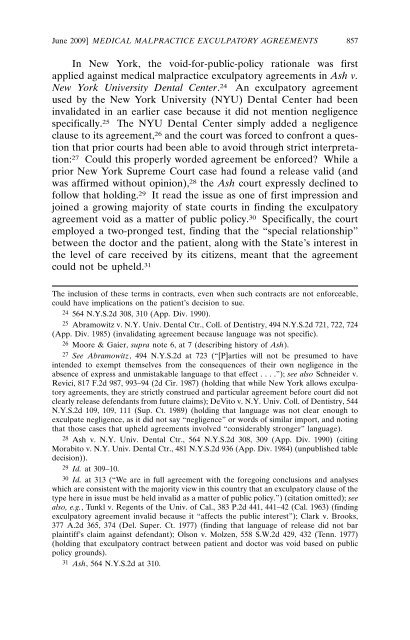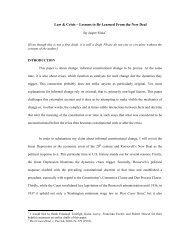In Search of an Enforceable Medical Malpractice Exculpatory
In Search of an Enforceable Medical Malpractice Exculpatory
In Search of an Enforceable Medical Malpractice Exculpatory
Create successful ePaper yourself
Turn your PDF publications into a flip-book with our unique Google optimized e-Paper software.
June 2009] MEDICAL MALPRACTICE EXCULPATORY AGREEMENTS 857<br />
<strong>In</strong> New York, the void-for-public-policy rationale was first<br />
applied against medical malpractice exculpatory agreements in Ash v.<br />
New York University Dental Center. 24 An exculpatory agreement<br />
used by the New York University (NYU) Dental Center had been<br />
invalidated in <strong>an</strong> earlier case because it did not mention negligence<br />
specifically. 25 The NYU Dental Center simply added a negligence<br />
clause to its agreement, 26 <strong>an</strong>d the court was forced to confront a question<br />
that prior courts had been able to avoid through strict interpretation:<br />
27 Could this properly worded agreement be enforced? While a<br />
prior New York Supreme Court case had found a release valid (<strong>an</strong>d<br />
was affirmed without opinion), 28 the Ash court expressly declined to<br />
follow that holding. 29 It read the issue as one <strong>of</strong> first impression <strong>an</strong>d<br />
joined a growing majority <strong>of</strong> state courts in finding the exculpatory<br />
agreement void as a matter <strong>of</strong> public policy. 30 Specifically, the court<br />
employed a two-pronged test, finding that the “special relationship”<br />
between the doctor <strong>an</strong>d the patient, along with the State’s interest in<br />
the level <strong>of</strong> care received by its citizens, me<strong>an</strong>t that the agreement<br />
could not be upheld. 31<br />
The inclusion <strong>of</strong> these terms in contracts, even when such contracts are not enforceable,<br />
could have implications on the patient’s decision to sue.<br />
24 564 N.Y.S.2d 308, 310 (App. Div. 1990).<br />
25 Abramowitz v. N.Y. Univ. Dental Ctr., Coll. <strong>of</strong> Dentistry, 494 N.Y.S.2d 721, 722, 724<br />
(App. Div. 1985) (invalidating agreement because l<strong>an</strong>guage was not specific).<br />
26 Moore & Gaier, supra note 6, at 7 (describing history <strong>of</strong> Ash).<br />
27 See Abramowitz, 494 N.Y.S.2d at 723 (“[P]arties will not be presumed to have<br />
intended to exempt themselves from the consequences <strong>of</strong> their own negligence in the<br />
absence <strong>of</strong> express <strong>an</strong>d unmistakable l<strong>an</strong>guage to that effect . . . .”); see also Schneider v.<br />
Revici, 817 F.2d 987, 993–94 (2d Cir. 1987) (holding that while New York allows exculpatory<br />
agreements, they are strictly construed <strong>an</strong>d particular agreement before court did not<br />
clearly release defend<strong>an</strong>ts from future claims); DeVito v. N.Y. Univ. Coll. <strong>of</strong> Dentistry, 544<br />
N.Y.S.2d 109, 109, 111 (Sup. Ct. 1989) (holding that l<strong>an</strong>guage was not clear enough to<br />
exculpate negligence, as it did not say “negligence” or words <strong>of</strong> similar import, <strong>an</strong>d noting<br />
that those cases that upheld agreements involved “considerably stronger” l<strong>an</strong>guage).<br />
28 Ash v. N.Y. Univ. Dental Ctr., 564 N.Y.S.2d 308, 309 (App. Div. 1990) (citing<br />
Morabito v. N.Y. Univ. Dental Ctr., 481 N.Y.S.2d 936 (App. Div. 1984) (unpublished table<br />
decision)).<br />
29 Id. at 309–10.<br />
30 Id. at 313 (“We are in full agreement with the foregoing conclusions <strong>an</strong>d <strong>an</strong>alyses<br />
which are consistent with the majority view in this country that <strong>an</strong> exculpatory clause <strong>of</strong> the<br />
type here in issue must be held invalid as a matter <strong>of</strong> public policy.”) (citation omitted); see<br />
also, e.g., Tunkl v. Regents <strong>of</strong> the Univ. <strong>of</strong> Cal., 383 P.2d 441, 441–42 (Cal. 1963) (finding<br />
exculpatory agreement invalid because it “affects the public interest”); Clark v. Brooks,<br />
377 A.2d 365, 374 (Del. Super. Ct. 1977) (finding that l<strong>an</strong>guage <strong>of</strong> release did not bar<br />
plaintiff’s claim against defend<strong>an</strong>t); Olson v. Molzen, 558 S.W.2d 429, 432 (Tenn. 1977)<br />
(holding that exculpatory contract between patient <strong>an</strong>d doctor was void based on public<br />
policy grounds).<br />
31 Ash, 564 N.Y.S.2d at 310.
















